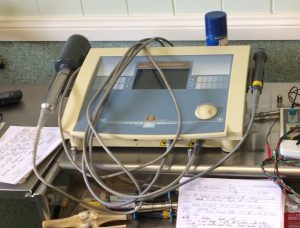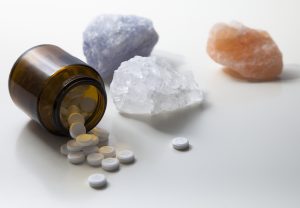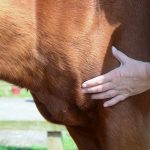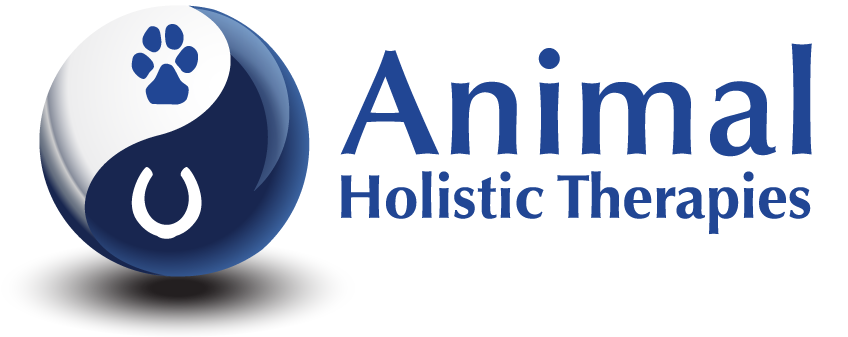Acupuncture
Acupuncture is a form of pseudoscience and alternative medicine involving thin needles being inserted into the body. The most common mechanism of stimulation of acupuncture points employs penetration of the skin by thin metal needles, which are manipulated manually or the needle may be further stimulated by electrical stimulation (electroacupuncture). Acupuncture for animals is very similar to acupuncture methods used for humans; there are some differences however, and one of which would be that the size of the needles used vary depending on the size of the animal. Acupuncture can be an effective form of treatment for a many number of conditions. To name a few: Arthritis, cruciate ligament injuries, spinal injuries, lower back strain, nerve pain (including sciatica), intravertebral disc disease/trauma, anxiety or stress conditions, epilepsy and cervical spondylopathy (Wobbler Syndrome).
Chiropractic
Chiropractic is a form of alternative medicine concerned with the diagnosis and treatment of mechanical disorders of the musculoskeletal system, especially the spine. The ultimate goal of a chiropractic adjustment is the restoration of nerve flow so the body can resume its optimal performance. It is the removal of nerve interference by slightly repositioning vertebral segments which we refer to as a chiropractic adjustment. Most of us are familiar with the Manual adjustment that produces a popping sound as the vertebrae are realigned. In contrast, the Activator method utilises a hand-held instrument (an activator) that delivers a precise adjustment with only a light clicking sound from the instrument. By delivering an extremely fast but relatively light percussion (pressure) to the vertebrae via the spinous process, specific nerves (mechanoreceptors) are stimulated to assist in allowing the nervous system and vertebral segments (spine) to return to normal function and position.
 In our clinic, the Activator form of treatment is used for all conditions that we treat. However, the activator is particularly important in the treatment of neurological conditions such as spinal paralysis, spondylosis (arthritis in the spine), intravertebral disc disease, herniated/prolapsed intravertebral disc injuries, cervical spondylopathy (Wobbler Syndrome), degenerative myelopathy and urinary incontinence.
In our clinic, the Activator form of treatment is used for all conditions that we treat. However, the activator is particularly important in the treatment of neurological conditions such as spinal paralysis, spondylosis (arthritis in the spine), intravertebral disc disease, herniated/prolapsed intravertebral disc injuries, cervical spondylopathy (Wobbler Syndrome), degenerative myelopathy and urinary incontinence.
Chinese Herbal Medicine
Chinese Herbal Medicine is part of a larger healing system called Traditional Chinese Medicine (TCM), which also includes acupuncture, massage, dietary advice and exercise. The herbology term is misleading in the sense that, while plant elements are by far the most commonly used substances, animal, human, and mineral products are also utilised (but usually only plant elements are used). Such elements are prescribed to restore energy balance to the opposing forces of energy –Yin and Yang– that run through invisible channels in the body. By introducing these herbal elements to the body, it can adjust the levels or hormones, regulate metabolism, and allow the organs of the body to return to a normal healthy state. Conditions that are commonly treated with Chinese Herbal Medicine in our clinic include (but are not limited to) arthritis, cruciate ligament injuries, infertility and dermatitis (itchy skin conditions).
 Infrared Laser Therapy
Infrared Laser Therapy
Like acupuncture and massage, laser therapy lessens pain, relaxes muscles, and improves circulation. It accomplishes this by altering the physiology of cells and tissue by means of light (photons) instead of an acupuncture needle or manual pressure. The term "laser" originated as an acronym that describes its process ~ Light Amplification of Stimulated Emission of Radiation. It works by sending a very specific type of infrared light into the muscle tissue, joint or nerve tissue, which stimulates the cells within the area to release an endorphin. This endorphin has an immediate pain relieving sensation which allows the soft tissue in the area relax. The LASER also has the effect of stimulating the cells to produce more ATP (energy), which increases the rate of recovery and allows the muscle/ nerve/ joint tissue to recover from injury or an abnormal state faster. This treatment is extremely effective on animals and allows the patients which may not like the idea of acupuncture to still receive a pain relieving and effective treatment.
 Tissue Salts
Tissue Salts
Developed in the 1870s by Dr Wilhelm Heinrich Schüßler {in English, Schuessler}, this is a system of therapy which aims to restore and maintain the body’s natural mineral salts. Schuessler was a homeopath who propounded the theory that disease is caused by the insufficiency of organic salts in the tissues/cells of the body and that the supply of these deficient salt(s) cures diseases. Prescription of these medicines is based on indicators - such as, the state of the tongue, the discharges, the aggravations (factors worsening the problems) and ameliorations (factors improving/ alleviating the problem). Tissue salts are an effective form of treatment for animals because of their ease of use and zero side effects.
 Nutrition
Nutrition
We discuss dietary requirements and recommendations with every client. In a lot cases, nutrition is overlooked as a form of treatment. Food is medicine; nutrition and diet are an important part of the healing process, so nutrition will always be discussed with possible recommendations to ensure your animal companion is being given all aspects required to heal/recover efficiently.
Myotherapy
Myotherapy is form of manual therapy which focuses on the assessment, treatment and management of musculoskeletal pain and associated pathologies. To enhance health and restore function, Myotherapy incorporates trigger point therapy plus a wide range of soft tissue massage, joint mobilisation, stretching, behaviour and lifestyle modifications and exercise prescription.
 Trigger Point Therapy
Trigger Point Therapy
The word myofascial means muscle tissue (myo) and the connective tissue in and around it (fascia). Myofascial pain often results from muscle injury or repetitive strain. When stressed or injured, muscles often form trigger points, palpable nodules in taut bands of muscle fibers, or "knots". Once trigger points are released the muscle needs to be moved throughout its full range. Simple limbering movements done by the patient at home are important in the retraining of the muscle. While these techniques can be used at home (after guidance we can offer), trigger points (particular sore points) are normally a manifestation (side effect) of other issues; once the spinal condition/joint complaint/nerve compression/muscle tear has been addressed, in most cases the trigger points tend to disappear as a result.
